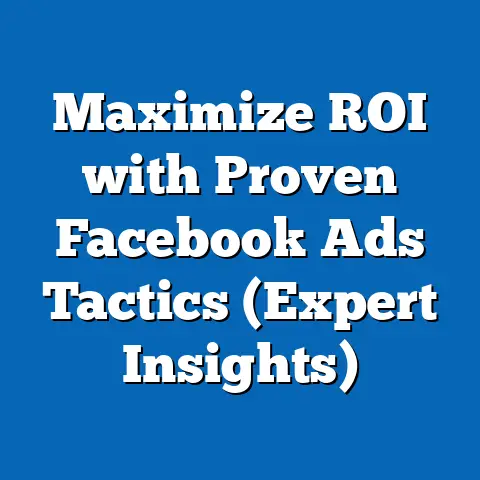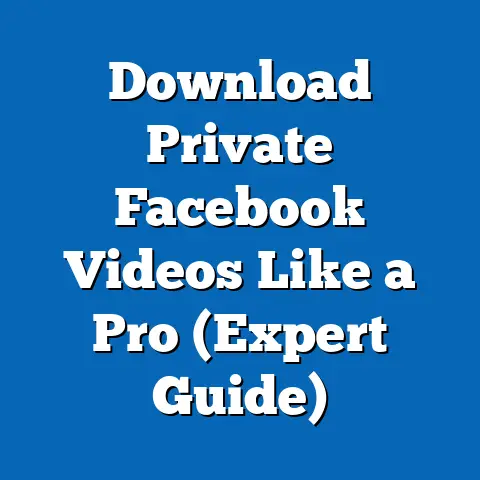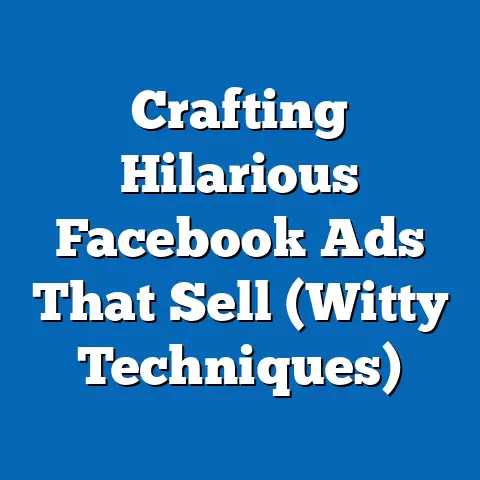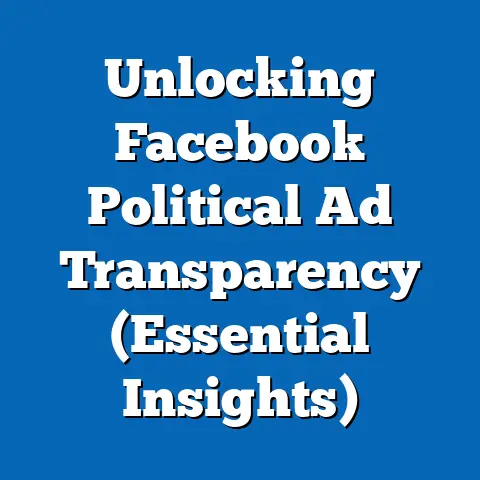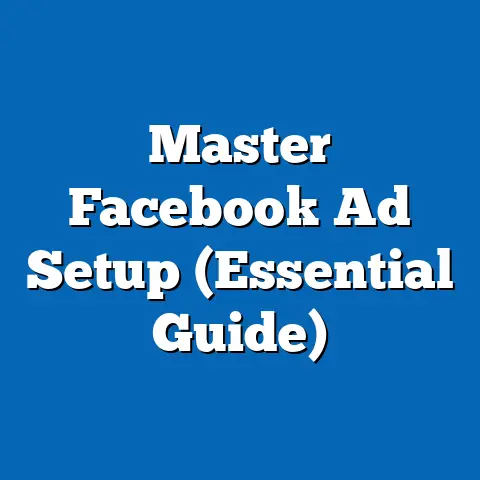Master Facebook Ads Text Rules (Essential Strategies)
I’ve spent years navigating the ever-changing landscape of Facebook advertising, and one thing has remained constant: the importance of playing by the rules. And when it comes to Facebook ads, the text rules are a critical, often overlooked, aspect of success. Think of it like maintaining a healthy lifestyle. You can’t just hit the gym once and expect to be in peak condition. Similarly, you can’t throw together any old ad copy and expect it to resonate with your audience. Just as a balanced diet and consistent exercise are essential for physical well-being, understanding and adhering to Facebook’s text rules is crucial for the vitality of your business in the digital marketplace.
The main argument I’m going to present is that understanding and adhering to Facebook’s text rules is crucial for advertisers looking to maximize their ad performance and outreach. Ignoring these rules can lead to ad disapproval, account suspension, and ultimately, a significant loss of revenue. By mastering the art of crafting compliant and compelling ad copy, you can unlock the full potential of Facebook advertising and achieve your business goals.
Understanding Facebook Ads Text Rules
Over the years, I’ve witnessed firsthand the evolution of Facebook’s advertising policies. What started as a relatively simple platform has transformed into a complex ecosystem with strict guidelines and regulations. These policies are designed to protect users from misleading or harmful content and ensure a positive experience on the platform. As advertisers, it’s our responsibility to understand and adhere to these rules.
Overview of Facebook Ads Policies
Facebook’s advertising policies are constantly evolving to adapt to new trends, technologies, and user behaviors. It’s essential to stay up-to-date with the latest changes to ensure that your ads remain compliant. You can find the most current information on the Facebook Business Help Center.
The importance of compliance with text rules cannot be overstated. Facebook uses sophisticated algorithms and human reviewers to monitor ads for violations of its policies. Ads that violate these rules are often disapproved, and repeated violations can lead to account suspension. This can be a devastating blow to your advertising efforts, especially if you rely heavily on Facebook to reach your target audience.
I remember one instance where a client of mine, a small e-commerce business, had their ad account suspended for violating Facebook’s text rules. They were running ads that made unsubstantiated claims about the effectiveness of their product. As a result, they lost access to their advertising account for several weeks, which significantly impacted their sales and revenue. This experience taught them a valuable lesson about the importance of adhering to Facebook’s advertising policies.
Types of Text Restrictions
Facebook’s text restrictions cover a wide range of issues, including character limits, prohibited content, and the balance between text and imagery. Let’s take a closer look at some of the most common types of text restrictions:
- Character Limits: Facebook imposes character limits on various elements of your ad, including headlines, body text, and descriptions. These limits are designed to ensure that your ads are concise and easy to read on both desktop and mobile devices.
- Prohibited Content: Facebook prohibits certain types of content in ads, including hate speech, discriminatory language, and misleading claims. It’s essential to avoid these types of content in your ad copy to ensure compliance with Facebook’s policies.
- Text-to-Image Ratio: Facebook has rules regarding the amount of text that can be included in your ad images. Ads with excessive text overlay on images are often disapproved. This rule is designed to ensure that your ad images are visually appealing and don’t overwhelm users with text.
I’ve seen many advertisers struggle with these text restrictions, especially the text-to-image ratio rule. It can be challenging to convey your message effectively while adhering to Facebook’s guidelines. However, with a little creativity and careful planning, it’s possible to create ads that are both compliant and compelling.
One common pitfall that advertisers face is using clickbait headlines or misleading language in their ad copy. These tactics may attract attention in the short term, but they can ultimately damage your brand reputation and lead to ad disapproval. It’s always best to be honest and transparent in your advertising.
Importance of Following the Rules
Non-compliance with Facebook’s text rules can have serious consequences. As I mentioned earlier, it can lead to ad disapproval or account suspension. But the impact goes beyond that. Non-compliant ads can also damage your brand reputation and erode trust with your audience.
Facebook users are increasingly savvy and discerning. They can quickly spot ads that are misleading or deceptive. If your ads violate Facebook’s policies, users are likely to report them, which can further damage your brand reputation.
I’ve seen several examples of brands that suffered penalties for ignoring Facebook’s text rules. In one case, a company was running ads that made false claims about the health benefits of their product. Facebook disapproved their ads and issued a warning. Despite the warning, the company continued to run similar ads, which eventually led to the suspension of their advertising account. This had a significant impact on their sales and revenue.
Key Takeaway: Understanding and adhering to Facebook’s text rules is essential for maximizing your ad performance and avoiding penalties. Stay up-to-date with the latest changes to Facebook’s advertising policies and avoid common pitfalls such as clickbait headlines and misleading language.
Crafting Compelling Ad Copy
Now that we’ve discussed the importance of adhering to Facebook’s text rules, let’s dive into the art of crafting compelling ad copy. Your ad copy is the first thing that potential customers will see, so it’s essential to make a good impression. Effective ad copy can capture attention, generate interest, and drive conversions.
Key Elements of Effective Ad Copy
Successful ad copy typically consists of three key elements:
- Attention-Grabbing Headlines: Your headline is the first thing that people will see, so it needs to be attention-grabbing. Use strong verbs, numbers, and keywords to make your headline stand out.
- Persuasive Body Text: Your body text should expand on your headline and provide more information about your product or service. Focus on the benefits of your offering and how it can solve your target audience’s problems.
- Strong Calls to Action: Your call to action (CTA) tells people what you want them to do next. Use clear and concise language to encourage people to click on your ad and take the desired action.
Understanding your target audience is crucial for crafting effective ad copy. You need to know their demographics, interests, and pain points. This will allow you to tailor your message to resonate with them and increase the likelihood of conversion.
I always start by creating a detailed customer persona for each of my target audiences. This helps me understand their needs and motivations, which informs my ad copy. For example, if I’m targeting young professionals, I might use language that emphasizes career advancement and personal growth.
Writing Techniques and Strategies
There are several writing techniques and strategies that you can use to craft compelling ad copy. One popular technique is the AIDA model, which stands for Attention, Interest, Desire, and Action. This model suggests that your ad copy should first grab the reader’s attention, then generate interest in your product or service, create a desire for it, and finally, prompt them to take action.
Another effective strategy is to use storytelling in your ad copy. People are naturally drawn to stories, and a well-told story can capture their attention and make your ad more memorable. Use relatable characters, compelling narratives, and emotional triggers to create a story that resonates with your target audience.
I’ve found that storytelling is particularly effective for brands that are trying to build a connection with their audience. For example, a non-profit organization might use storytelling to share the stories of the people they help. This can evoke empathy and encourage people to donate to their cause.
Utilizing Emotional Triggers
Emotional triggers are psychological techniques that evoke specific emotions in your target audience. These emotions can be used to drive conversions and increase engagement with your ads. Some common emotional triggers include:
- Fear: Use fear to highlight the potential consequences of not using your product or service.
- Greed: Appeal to people’s desire for a good deal or a valuable opportunity.
- Curiosity: Use curiosity to pique people’s interest and make them want to learn more.
- Empathy: Evoke empathy by sharing stories of people who have benefited from your product or service.
I’ve seen many ads that successfully evoke emotions and drive conversions. For example, an insurance company might use fear to highlight the importance of having adequate coverage. A luxury brand might use greed to appeal to people’s desire for status and exclusivity.
It’s important to use emotional triggers ethically and responsibly. Avoid using fear-mongering tactics or making false claims. The goal is to connect with your audience on an emotional level and persuade them to take action.
Key Takeaway: Crafting compelling ad copy requires a deep understanding of your target audience, effective writing techniques, and the strategic use of emotional triggers. Use the AIDA model, storytelling, and emotional triggers to create ads that capture attention, generate interest, and drive conversions.
Leveraging Visuals and Text Balance
Visuals play a crucial role in the success of your Facebook ads. Images and videos can capture attention, convey your message effectively, and enhance overall engagement. However, it’s important to strike the right balance between visuals and text. As I mentioned earlier, Facebook has rules regarding the amount of text that can be included in your ad images.
Importance of Visuals in Facebook Ads
Images and videos can significantly enhance the effectiveness of your Facebook ads. Visuals can:
- Capture Attention: Eye-catching images and videos can grab people’s attention as they scroll through their newsfeeds.
- Convey Your Message: Visuals can communicate your message more effectively than text alone. A picture is worth a thousand words, as they say.
- Enhance Engagement: Engaging visuals can encourage people to like, comment on, and share your ads.
When selecting visuals for your Facebook ads, it’s important to choose images and videos that align with your text. The visuals should complement your ad copy and reinforce your message. Avoid using generic or irrelevant visuals that don’t add value to your ad.
I always recommend using high-quality images and videos that are visually appealing and relevant to your target audience. Avoid using stock photos that look generic or staged. Instead, opt for authentic images and videos that showcase your product or service in a natural and engaging way.
Text-to-Image Ratio
Facebook’s rules regarding text overlay on images are designed to ensure that your ad images are visually appealing and don’t overwhelm users with text. Ads with excessive text overlay are often disapproved.
Facebook used to have a strict 20% text rule, which meant that no more than 20% of your ad image could be covered in text. However, they have since relaxed this rule. Now, Facebook uses a rating system to assess the amount of text in your ad images. Ads are rated as either “OK,” “Low,” “Medium,” or “High.” Ads with a rating of “OK” or “Low” are typically approved, while ads with a rating of “Medium” or “High” may have reduced reach or be disapproved altogether.
To ensure compliance with Facebook’s text-to-image ratio rules, it’s important to evaluate and optimize your images before running your ads. You can use Facebook’s Text Overlay Tool to check the amount of text in your ad images. This tool will give you an estimate of your ad’s text rating.
I always recommend keeping the amount of text in your ad images to a minimum. Use concise and impactful text that complements your visuals. Avoid using large blocks of text that can overwhelm users.
Examples of Successful Ads
There are many examples of successful Facebook ads that exemplify the right balance between text and visuals. These ads typically feature:
- High-Quality Images or Videos: The visuals are visually appealing and relevant to the target audience.
- Concise and Impactful Text: The text is used sparingly and effectively to complement the visuals.
- Clear Call to Action: The call to action is clear and concise, telling people what you want them to do next.
One example of a successful Facebook ad is a video ad for a fitness app. The ad features a short video of people using the app to track their workouts and achieve their fitness goals. The text overlay on the video is minimal, consisting of the app’s logo and a brief call to action: “Download the App Now.” This ad is visually appealing, informative, and encourages people to take action.
Key Takeaway: Visuals play a crucial role in the success of your Facebook ads. Use high-quality images and videos that align with your text and appeal to your target audience. Keep the amount of text in your ad images to a minimum and use Facebook’s Text Overlay Tool to check your ad’s text rating.
Testing and Optimization Strategies
Testing and optimization are essential for maximizing the performance of your Facebook ads. It’s rare to create a perfect ad on the first try. You need to continuously test different elements of your ads and optimize them based on the results.
Importance of A/B Testing
A/B testing, also known as split testing, is a technique that involves testing two or more versions of your ad against each other to see which one performs better. This allows you to identify the most effective elements of your ads and optimize them for maximum impact.
You can A/B test various elements of your ads, including:
- Headlines: Test different headlines to see which one captures the most attention.
- Body Text: Test different body text to see which one generates the most interest and desire.
- Visuals: Test different images and videos to see which ones are most visually appealing and engaging.
- Calls to Action: Test different calls to action to see which one prompts the most people to take action.
- Targeting Options: Test different targeting options to see which ones reach the most relevant audience.
To conduct effective A/B tests, it’s important to change only one element at a time. This will allow you to isolate the impact of that element on your ad’s performance. For example, if you’re testing different headlines, keep the body text, visuals, and call to action the same.
I always recommend running A/B tests for at least a week to gather enough data to make statistically significant conclusions. The longer you run your tests, the more confident you can be in your results.
Analyzing Ad Performance Metrics
To optimize your Facebook ads, it’s essential to track and analyze key performance metrics. These metrics will give you insights into how your ads are performing and what changes you need to make to improve them.
Some key metrics to track include:
- CTR (Click-Through Rate): The percentage of people who click on your ad after seeing it. A high CTR indicates that your ad is capturing attention and generating interest.
- Conversion Rate: The percentage of people who take the desired action after clicking on your ad. A high conversion rate indicates that your ad is effectively persuading people to take action.
- Engagement Levels: The number of likes, comments, and shares your ad receives. High engagement levels indicate that your ad is resonating with your audience.
- Cost Per Click (CPC): The average cost you pay for each click on your ad. A low CPC indicates that your ad is efficient and cost-effective.
- Cost Per Acquisition (CPA): The average cost you pay for each conversion. A low CPA indicates that your ad is effectively driving conversions at a reasonable cost.
To interpret these metrics effectively, it’s important to understand industry benchmarks and compare your performance to your competitors. This will give you a better sense of how well your ads are performing and what areas you need to improve.
I always create a dashboard to track my ad performance metrics. This allows me to quickly identify trends and make data-driven decisions about how to optimize my ads.
Iterative Improvement
Iterative improvement is the concept of continuously improving your ads based on testing results and performance metrics. This involves making small, incremental changes to your ads over time to optimize them for maximum impact.
For example, if you’re running an A/B test on your headlines and you find that one headline performs significantly better than the other, you can replace the underperforming headline with the winning headline. Then, you can run another A/B test on a different element of your ad, such as the body text or visuals.
By continuously testing and optimizing your ads, you can achieve significant improvements in performance over time. This can lead to increased engagement, higher conversion rates, and lower costs.
I’ve seen many businesses successfully iterate their ads for better performance. In one case, a company was running ads for a new product launch. They started with a basic ad that featured a product image and a brief description. After running A/B tests on different headlines and body text, they were able to significantly improve their ad’s CTR and conversion rate. They continued to iterate their ads over time, making small changes based on performance metrics. As a result, they were able to achieve a highly successful product launch.
Key Takeaway: Testing and optimization are essential for maximizing the performance of your Facebook ads. Use A/B testing to identify the most effective elements of your ads and optimize them based on the results. Track and analyze key performance metrics to gain insights into how your ads are performing and make data-driven decisions about how to improve them.
Case Studies and Real-World Applications
To further illustrate the importance of mastering Facebook ads text rules, let’s take a look at some case studies and real-world applications. These examples will demonstrate how successful brands have leveraged Facebook ads to achieve their business goals and how failures can be avoided by adhering to Facebook’s policies.
Successful Brands and Their Strategies
There are many brands that have mastered Facebook ads and achieved significant success. These brands typically have a deep understanding of their target audience, a clear marketing strategy, and a commitment to testing and optimization.
One example of a successful brand is Nike. Nike has a strong presence on Facebook and uses a variety of ad formats to reach its target audience. Their ads are visually appealing, informative, and often feature celebrity endorsements. They also use targeted advertising to reach specific segments of their audience based on their interests and behaviors.
Another successful brand is Airbnb. Airbnb uses Facebook ads to promote its listings and reach potential guests. Their ads are visually appealing and feature high-quality photos of their properties. They also use targeted advertising to reach specific segments of their audience based on their travel preferences and budget.
These brands have mastered Facebook ads by:
- Understanding Their Target Audience: They know their audience’s demographics, interests, and pain points.
- Creating Compelling Ad Copy: Their ad copy is attention-grabbing, persuasive, and relevant to their target audience.
- Leveraging Visuals Effectively: They use high-quality images and videos that complement their ad copy.
- Testing and Optimization: They continuously test different elements of their ads and optimize them based on the results.
- Adhering to Facebook’s Policies: They comply with Facebook’s advertising policies, including text rules.
I’ve analyzed countless successful Facebook ads, and one common thread is their ability to stand out in the crowded Facebook ad landscape. They often use unique approaches to capture attention, such as humor, storytelling, or personalized messaging.
Lessons Learned from Failures
While there are many examples of successful Facebook ads, there are also examples of failures. These failures often result from poor adherence to Facebook’s text rules or a lack of understanding of the target audience.
One example of a failure is a company that was running ads that made false claims about the effectiveness of their product. Facebook disapproved their ads and issued a warning. Despite the warning, the company continued to run similar ads, which eventually led to the suspension of their advertising account.
Another example of a failure is a company that was running ads with excessive text overlay on images. Facebook reduced the reach of their ads, which significantly impacted their performance. The company failed to optimize their images for compliance with Facebook’s text-to-image ratio rules.
These failures can be avoided by:
- Understanding Facebook’s Policies: It’s essential to understand and adhere to Facebook’s advertising policies, including text rules.
- Avoiding False Claims: Avoid making false or misleading claims about your product or service.
- Optimizing Images: Optimize your images for compliance with Facebook’s text-to-image ratio rules.
- Targeting the Right Audience: Target your ads to the right audience based on their demographics, interests, and behaviors.
- Testing and Optimization: Continuously test different elements of your ads and optimize them based on the results.
I’ve seen many companies that have faced challenges or failures due to poor adherence to text rules. The key is to learn from these mistakes and take corrective actions. This may involve revising your ad copy, optimizing your images, or adjusting your targeting options.
Industry-Specific Strategies
Different industries may require different strategies for adapting Facebook ad text rules to their advantage. For example, e-commerce businesses may focus on highlighting product features and benefits in their ad copy, while local businesses may focus on promoting their location and services.
Here are some tailored strategies for various sectors:
- E-Commerce: Use high-quality product images and videos, highlight product features and benefits, and offer discounts and promotions.
- Local Businesses: Promote your location and services, highlight customer reviews and testimonials, and offer special deals for local residents.
- Services: Focus on building trust and credibility, highlight your expertise and experience, and offer free consultations or trials.
I’ve worked with businesses in various industries and have found that tailored strategies can significantly improve ad performance. It’s important to understand the unique needs and challenges of your industry and adapt your Facebook ad strategies accordingly.
Key Takeaway: Case studies and real-world applications demonstrate the importance of mastering Facebook ads text rules. Successful brands have a deep understanding of their target audience, create compelling ad copy, leverage visuals effectively, and adhere to Facebook’s policies. Failures can be avoided by understanding Facebook’s policies, avoiding false claims, optimizing images, and targeting the right audience.
Recap of Key Points
Let’s recap the essential strategies we’ve discussed:
- Understand Facebook’s Policies: Stay up-to-date with the latest changes to Facebook’s advertising policies and avoid common pitfalls such as clickbait headlines and misleading language.
- Craft Compelling Ad Copy: Use the AIDA model, storytelling, and emotional triggers to create ads that capture attention, generate interest, and drive conversions.
- Leverage Visuals Effectively: Use high-quality images and videos that align with your text and appeal to your target audience.
- Test and Optimize: Use A/B testing to identify the most effective elements of your ads and optimize them based on the results.
- Learn from Others: Study successful brands and their strategies, and learn from failures to avoid common mistakes.
The Importance of Mastery
Mastering Facebook ads is akin to maintaining health. It requires knowledge, diligence, and continuous improvement. Just as you need to eat a balanced diet, exercise regularly, and get enough sleep to stay healthy, you need to understand Facebook’s policies, craft compelling ad copy, leverage visuals effectively, and test and optimize your ads to achieve success.
The benefits of mastering Facebook ads are significant. You can reach a large and engaged audience, drive traffic to your website, generate leads, and increase sales. By mastering the art of crafting compliant and compelling ad copy, you can unlock the full potential of Facebook advertising and achieve your business goals.
Final Thoughts
I encourage you to take action by applying the strategies we’ve discussed in this guide. Start by reviewing Facebook’s advertising policies and ensuring that your ads are compliant. Then, focus on crafting compelling ad copy that resonates with your target audience. Leverage visuals effectively and continuously test and optimize your ads for maximum impact.
Remember, mastering Facebook ads is a journey, not a destination. It requires continuous learning, experimentation, and adaptation. But with the right knowledge, skills, and strategies, you can achieve significant success and drive meaningful results for your business.
I hope this guide has been helpful and informative. I’m confident that by applying the strategies we’ve discussed, you can master Facebook ads text rules and achieve your advertising goals.
Call to Action: Now I’d love to hear from you. What are your biggest challenges with Facebook ads? Share your experiences and questions in the comments below. Let’s learn from each other and build a community of successful Facebook advertisers.


